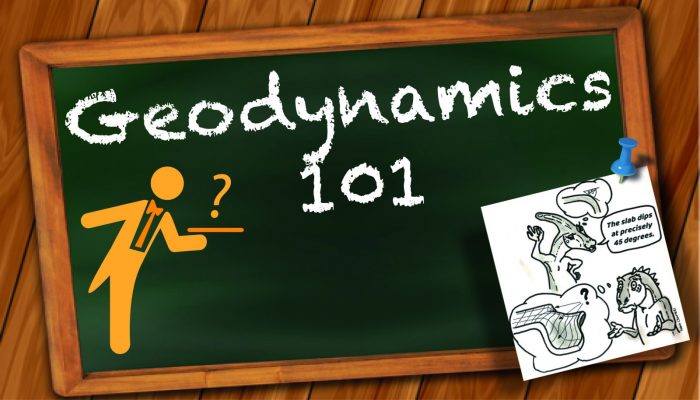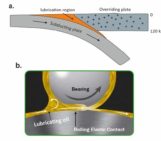
The Geodynamics 101 series serves to showcase the diversity of research topics and methods in the geodynamics community in an understandable manner. We welcome all researchers – PhD students to professors – to introduce their area of expertise in a lighthearted, entertaining manner and touch upon some of the outstanding questions and problems related to their fields. For our latest ‘Geodynamics 101’ post, Fabio Crameri, postdoctoral researcher at the Centre for Earth Evolution and Dynamics (CEED), University of Oslo, Norway, joins us again. Continuing from his earlier post on the harmful use of the rainbow colour map, Fabio shares his thoughts on some of the expressions and phrases used in the community that propagate confusion, and how the new “Ocean-Plate Tectonics” concept offers relief for at least some on them.

Blog author Fabio Crameri – in a shirt that translates from Tamasheq as “deserts” or “empty spaces.” You can expect no empty spaces in your lunchtime conversations after reading this post.
Do you, after reading the title, still wonder what this blog post is all about?
I’ll give you a hint, it’s about the Earth. No, wait, it’s about Earth, or perhaps earth, or isn’t it? And maybe it is a little bit about Moon, I mean the Moon. But also, it is about the Venus, I mean Venus.
It is not confusing, it is just well mixing.
You’ve got it; it is about confusion in the Geosciences. Confusion caused by symbols, letters, words and phrases through misuse, ambiguity or over-interpretation. So, after all, this is a blog post about geo-semantics rather than about culinary excursions.
The Geodynamics community is a diverse group of people with different backgrounds, native languages and customs. This is an attractive breeding ground for semantic related problems, particularly when you throw in some inherent peculiarities of the English language in which we largely operate.
Some use the symbol “a” for years, for years and years.
In line with a widely used standard definition (Holden et al., 2011) – but against the common convention of the Geosciences – the author of this blog post was using the unit of time “a”, or arguably just its symbol, for “years” (and I mean calendar years, neither financial years nor dog years), for years and years. A distinction between discrete points in time and the duration of time is at the heart of this confusion, and indeed has plagued a sub-selection of discussions, working groups and interpretations of the International System of Units (SI; e.g., Christie-Blick, 2012).

Figure 1. An ambiguously phrased situation near the recent end of the Cretaceous.
The symbol “a” for “annus” [year] (“Ma” being the symbol for 106 years, or “mega-annus”) in the Geosciences is most commonly used for a specific time or date in the past as measured from now. For example, “At 65 Ma (which is 65 Myr ago), the dinosaur looked up the sky.” (see Figure 1). On the other hand, “yr” for “year(s)” is commonly used for a duration of time, as in “The Cretaceous period ran for 79 Myr (from approximately 145-66 Ma).”. Other mutations within the convention of time in the Geosciences include “My”, “Myrs”, “Mya” or “m.y.” for “Millions of years”. Thus, the time unit and symbols for multiples of a “year” are likely amongst the most ambiguous expressions in the Earth Sciences, likely because, in contrast to the “second”, a universally applied scientific definition for the “annus” still remains elusive (Thompson and Taylor, 2008).
Such quibbling over semantics may seem petty.
Amongst other examples to cause geodynamic misunderstandings (e.g., Figure 2) might be the misuse of the phrase “stagnant slabs”? Are slabs ever really stagnant? Or are they just being deflected, slowing down, interrupting their downward motion, not directly entering the lower mantle at the same speed and trajectory as before?

Figure 2. One ambiguously phrased geodynamic explanation.
From the literature, you might be forgiven for having the false impression that slabs either fully stagnate around the upper-mantle transition zone or directly and effortlessly penetrate it; they likely do neither of the two (as explained in e.g., in an earlier Geodynamics101 post here).
When these slabs sink, and not temporally stagnate, they induce flow in the surrounding mantle. “Slab suction” is the downward suction induced by the nearby mantle that is set in motion through its dynamic coupling with the slab [e.g., Conrad and Lithgow-Bertelloni 2002]. Or isn’t it? “Slab suction” is also contrarily used as an upward directed force on the slab itself that is induced by the upper plate and might foster low-dipping shallow-depth slab portions in the uppermost upper mantle (unambiguously speaking of which: see again Figure 2).
The downward directed version of “slab suction” can induce “dynamic topography”. Estimates of the maximum amplitude of “dynamic topography” on Earth range from only a few hundred meters up to a few kilometres (see e.g., Molnar et al., 2015 and references therein). Such unusually large ranges of estimates are, as a general rule, a quite solid indicator for an underlying ambiguous definition, or in this case, rather a mix-up of multiple different definitions for the term “dynamic topography”.
If you’re not confused, you did not pay attention.
As I keep talking about geodynamics, I hope we are all on the same page about subduction, one of the key players: Let’s assume planet XY has one single active subduction zone. Another subduction zone initiates on the opposite side of the same planet. Did “subduction” start once or twice on that planet?
It started once on that planet. Because “subduction” describes a process and not a physical feature; it is nonetheless easily mistaken for a physical feature.
And what about “plate tectonics”, the 50 yr old overarching concept that fascinates us, and for so many of us has become the foundation of our professional lives. Let’s approach this by considering the big question: When did “plate tectonics” start? Serious opinions in the plate tectonics community range from around 850 Ma (Hamilton 2011) all the way back to 4.3 Ga (Hopkins et al., 2008). – Remember what unusually large estimate ranges often indicate? – It is not surprising that the only commonly accepted specific answer everyone seems to agree on currently is that it depends on the very definition of plate tectonics.
So, what is the definition of “plate tectonics”? According to its original formulation, “plate tectonics” is the horizontal relative movement of several discrete and mostly-rigid surface-plate segments (Hess, 1962; see the corresponding visual representation in Figure 3). A generous interpretation of the original formulation might additionally define the plate-interface nature, but that is all.

Figure 3. As long as it is not overinterpreted, there is nothing wrong with the original definition of plate tectonics that solely describes the horizontal motion of several discrete surface plates: It does not discriminate the oceanic from the continental plate, does not consider the important framework of mantle convection, and does not specify the underlying key driver of the surface motion.
Considering the knowledge we have gained about the moving surface plates and their underlying causes and consequences during the past 50 yr, this is an extremely broad definition: As of today, we know that (A) the surface plates with their relative motion are an integral part of whole mantle convection (Turcotte and Oxburgh, 1972), that (B) Earth’s surface has a characteristic bimodal nature due to the partitioning into long-lived continental plates and short-lived oceanic plates (e.g., Wilson, 1966), and that (C) the latter are mainly driven by their very own subducted portions (i.e., all or parts of their slabs; Forsyth and Uyeda, 1975; Conrad and Lithgow-Bertelloni, 2002).
A clear, unambiguous and up-to-date definition for such a crucially important, wide-reaching concept is imperative. It is therefore not surprising that less ambiguous re-definitions have been suggested recently. To avoid propagating confusion, the introduction of alternative phases of plate tectonics that describe the various different possible modes of mantle convection during Earth’s evolution have been cast into the arena (e.g., Sobolev 2016). These include “plate-tectonics phase 1”, in short “PT1”, describing regional, plume-induced plate tectonics (e.g., until 3.0 Ga), “PT2” describing episodic, global plate tectonics (e.g., between 2.5-1.0 Ga), and finally “PT3” describing stable, global plate tectonics (e.g., 1.0-0.0 Ga). Other efforts result in different naming conventions, such as “modern plate tectonics”. However, apart from the fact that “modern” is a time dependent term, “modern plate tectonics” might be a somewhat unfortunate expression, as other planets like Venus might have undergone different, modern styles of plate tectonics than present-day Earth.
Stern and Gerya (2017) then actually suggests an entire update to the definition of “plate tectonics”:
“A theory of global tectonics powered by subduction in which the lithosphere is divided into a mosaic of strong lithospheric plates, which move on and sink into weaker ductile asthenosphere. Three types of localised plate boundaries form the interconnected global network: new oceanic plate material is created by seafloor spreading at mid-ocean ridges, old oceanic lithosphere sinks at subduction zones, and two plates slide past each other along transform faults. The negative buoyancy of old dense oceanic lithosphere, which sinks in subduction zones, mostly powers plate movements.”
Unfortunately, such a re-definition of the same old phrase makes it impossible to know which version of the definition (i.e., the original or the updated one) an author of a subsequent study should be applying and referring to.
In an effort to prevent all of the above problems, we recently introduced an entirely new concept; one that can coexist in harmony with the original definition; one that fully captures the dynamics of the oceanic plate according to our current knowledge. The concept is called “Ocean-Plate Tectonics” or, if you really like the term, “OPT”.
“Ocean-Plate Tectonics is a mode of mantle convection characterised by the autonomous relative movement of multiple discrete, mostly rigid, portions of oceanic plates at the surface, driven and maintained principally by subducted parts of these same plates that are sinking gravitationally back into Earth’s interior and deforming the mantle interior in the process.” – Crameri et al. (2018).
“Ocean-Plate Tectonics” captures not only the relative horizontal surface motion of plates, but crucially also accounts for (A) the importance of the whole mantle framework, (B) the bimodal nature of Earth’s surface plates, and (C) the underlying engine of the surface-plate motion (see Figure 4).

Figure 4. “Ocean-Plate Tectonics”, the unambiguous up-to-date definition describing the dynamics of the oceanic plate that crucially incorporates the bimodal nature of Earth’s surface, the convecting-mantle framework, and the key driver of surface-plate motion (after Crameri et al., 2018).
“Ocean-Plate Tectonics” is here to serve Geoscientists.
The concept of “Ocean-Plate Tectonics” is intended to bring together the extremely diverse research communities, but also the general public, to meet on common, fruitful ground in order to discuss and further develop our understanding of the fascinating dynamics involved in Earth’s plate-mantle system; the unambiguous “Ocean-Plate Tectonics” is here to serve us.
Christie-Blick, N., (2011), Geological Time Conventions and Symbols, GSA Today, 22(2), 28-29, doi: 10.1130/G132GW.1 Conrad, C. P., and C. Lithgow-Bertelloni (2002), How mantle slabs drive plate tectonics, Science, 298 (5591), 207–209, doi:10.1126/science.1074161. Crameri, F., C.P. Conrad, L. Montési, and C.R. Lithgow-Bertelloni (2018), The life of an oceanic plate, Tectonophysics, (in press), doi:10.1016/j.tecto.2018.03.016 . Forsyth, D., and S. Uyeda (1975), On the relative importance of the driving forces of plate motion*, Geophysical Journal of the Royal Astronomical Society, 43(1), 163–200, doi:10.1111/j.1365-246X.1975.tb00631.x. Hamilton, W.B. (2011), Plate tectonics began in Neoproterozoic time, and plumes from deep mantle have never operated, Lithos, 123, 1–20, doi:10.1016/j.lithos.2010.12.007. Hess, H.H. (1962), History of ocean basins, Petrologic studies, 4, 599–620. Holden N.E., M.L. Bonardi, P. De Bièvre, P.R. Renne and I.M. Villa (2011), IUPAC-IUGS common definition and convention on the use of the year as a derived unit of time (IUPAC Recommendations 2011, Pure Appl. Chem., Vol. 83, No. 5, pp. 1159–1162, 2011. doi:10.1351/PAC-REC-09-01-22 Hopkins M., T.M. Harrison, C.E. Manning (2008), Low heat flow inferred from >4 Gyr zircons suggests Hadean plate boundary interactions, Nature, 456, 493–96, doi:10.1038/nature07465. Molnar, P., P. C. England, and C. H. Jones (2015), Mantle dynamics, isostasy, and the support of high terrain. J. Geophys. Res. Solid Earth, 120, 1932–1957. doi: 10.1002/2014JB011724. Sobolev, S.V. (2016), Plate Tectonics Initiation as Running Hurdles, Workshop on the Origin and Evolution of Plate Tectonics abstract, Ascona, Switzerland, http://jupiter.ethz.ch/~plates/. Stern, R.J. and T.V. Gerya (2017), Subduction initiation in nature and models: A review, Tectonophysics, doi:10.1016/j.tecto.2017.10.014 Thompson, A., and B.N. Taylor (2008), Guide for the Use of the International System of Units (SI) NIST Special Publication 811, 2008 Edition (version 3.2). [Online] Available: http://physics.nist.gov/SP811 [2018, 05 02]. National Institute of Standards and Technology, Gaithersburg, MD. Turcotte, D. L., and E. Oxburgh (1972), Mantle convection and the new global tectonics, Annual Review of Fluid Mechanics, 4 (1), 33–66. Wilson, T. (1966), Did the Atlantic close and then re-open?, Nature, 211(5050), 676–681, doi:http://dx.doi.org/10.1038/211676a0




